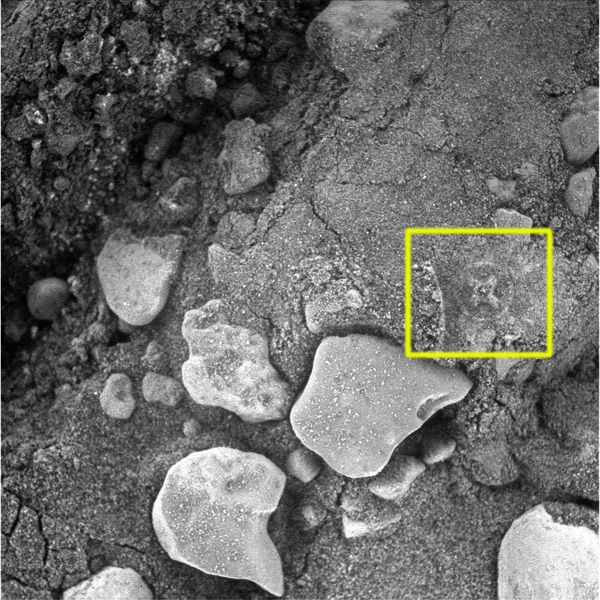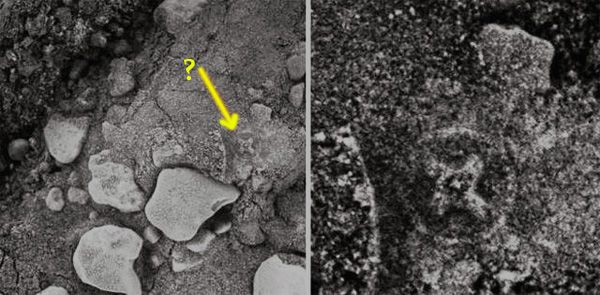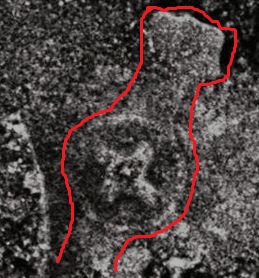It looks like you're using an Ad Blocker.
Please white-list or disable AboveTopSecret.com in your ad-blocking tool.
Thank you.
Some features of ATS will be disabled while you continue to use an ad-blocker.
share:
Guys! This one is quite an anomaly! A 'cross' embedded in Martian rock.
The anomaly, which was spotted in a photograph returned by NASA's Opportunity rover, consists of what looks like a perfect circle with a cross design in the center. However, the circular cross shape happens to bear an uncanny resemblance to the type of screw-heads found in the rover's Alpha particle X-ray Spectrometer tool.
The most likely explanation therefore is that the rover left an unintentional imprint of one of the spectrometer's screw-heads in the rock just before the photograph was taken. But then could the delicate spectrometer's screw-head make such an indentation into solid rock?
If not, then could there be another explanation too? Like an alien artifact embedded into the rock?
Here's the NASA image....


If you look closely, the indentation seems to be made in antiquity. Doesn't seem freshly scooped out!
What do you think?
mars.jpl.nasa.gov...edit on 21-10-2014 by OrionHunterX because: (no reason given)
Here is a picture of the APXS carried on the rover. Notice the screws around the rim? Notice the inner curve of the rim? Notice how the imprint
matches?
mars.jpl.nasa.gov...
The APXS is a "contact instrument" it is is pressed against the material it is analyzing.
mars.jpl.nasa.gov...
The APXS is a "contact instrument" it is is pressed against the material it is analyzing.
edit on 10/21/2014 by Phage because: (no reason given)
Posted & debunked already, sorry my friend. It was a screw imprint from the rover or something.
Already posted. It's an imprint of a screw, and it's in loose sand, not solid rock.
edit on 10/21/2014 by AdmireTheDistance because: (no reason
given)
a reply to: Phage
Its no fun when you make sense of it so fast phage!
Didn't look much like the celtic cross to begin with tho
Well looks like you weren't alone in that aspect
Its no fun when you make sense of it so fast phage!
Didn't look much like the celtic cross to begin with tho
Well looks like you weren't alone in that aspect
edit on stTue, 21 Oct 2014 01:19:28 -0500America/Chicago1020142880 by Sremmos80
because: (no reason given)
I am gonna have to disagree with you Phage, if that were the case the patterns would match or at least be similar and they are not. Nice try though
Debunkosaurus
originally posted by: Phage
a reply to: nrd101
Actually, they do. The screw head. The inner curve of the rim.
Perfect match because that's what made it.
That is why I disagree, in your pic there are many repeating concentric circles that are not present
on the image from mars. In fact, It shows a different cross type pattern.
originally posted by: nrd101
originally posted by: Phage
a reply to: nrd101
Actually, they do. The screw head. The inner curve of the rim.
Perfect match because that's what made it.
That is why I disagree, in your pic there are many repeating concentric circles that are not present
on the image from mars. In fact, It shows a different cross type pattern.
What nrd101 is referring to is the fact that the martian imprint has 4 holes. Phage's image clearly has 6 holes. Because nrd101 and I have superb spacial ability and abstract reasoning skills , we are quickly and accurately able to determine that the patterns do not match.
Spatial visualization ability or visual-spatial ability is the ability to mentally manipulate 2-dimensional and 3-dimensional figures. It is typically measured with simple cognitive tests and is predictive of user performance with some kinds of user interfaces.
I rarely post, but this one is too obvious not too, I think theres more to that martian imprint, star if you agree.
originally posted by: AdmireTheDistance
Already posted. It's an imprint of a screw, and it's in loose sand, not solid rock.
It seems to me that this is especially why there should be an imprint of more than one screw visible. If it is indeed, a screw at all.
a reply to: MoonBlossom
So, it's a recent imprint in the dust? What do you think made it?
Heres a little experiment you can do at home. Make a little pile of cornstarch or something finer. Don't level it out, just a bump of dust. Use a can of soup and push it down on the pile, off center. Not too hard. The can is circular right? Is the impression a circle, or an arc?
www.abovetopsecret.com...
So, it's a recent imprint in the dust? What do you think made it?
Heres a little experiment you can do at home. Make a little pile of cornstarch or something finer. Don't level it out, just a bump of dust. Use a can of soup and push it down on the pile, off center. Not too hard. The can is circular right? Is the impression a circle, or an arc?
www.abovetopsecret.com...
edit on 10/21/2014 by Phage because: (no reason given)
a reply to: OrionHunterX
Interesting picture!
I even see a handle on top of the circular object, angled to the right

Interesting picture!
I even see a handle on top of the circular object, angled to the right

edit on 21-10-2014 by skido because: (no reason given)
The imprint theory doesn't explain the square structure above and below the circular item ...looks like if they were testing they were testing the
long squared structure just covered by the dirt.
a reply to: DooDer
Umm, that screw in the pic you post there looks tiny in comparison to that imprint on Mars..............
Also, the cross section of the screw in your pic doesn't even match that cross imprint.
Umm, that screw in the pic you post there looks tiny in comparison to that imprint on Mars..............
Also, the cross section of the screw in your pic doesn't even match that cross imprint.
edit on 21-10-2014 by Vrill because: (no reason
given)
new topics
-
The trial on kids was stopped
Medical Issues & Conspiracies: 2 minutes ago -
Orbs Appear And Form Triangle On Live Cam.
Aliens and UFOs: 1 hours ago -
Biden Has New Bizarre Injuries to His Face
Politicians & People: 3 hours ago -
Something is not adding up in regards to the H-1B commotion
General Conspiracies: 3 hours ago -
Elon Musk Calls for Tommy Robinson to be Freed - and Takes a Dig at Starmer
Politicians & People: 4 hours ago -
Biden to award Presidential Citizens Medal to Liz Cheney and Bennie Thompson
US Political Madness: 4 hours ago -
Just learned a really helpful trick for internet searches
Computer Help: 10 hours ago
top topics
-
Biden Has New Bizarre Injuries to His Face
Politicians & People: 3 hours ago, 9 flags -
Just learned a really helpful trick for internet searches
Computer Help: 10 hours ago, 7 flags -
Biden to award Presidential Citizens Medal to Liz Cheney and Bennie Thompson
US Political Madness: 4 hours ago, 7 flags -
Not off to a good start
General Chit Chat: 12 hours ago, 6 flags -
Elon Musk Calls for Tommy Robinson to be Freed - and Takes a Dig at Starmer
Politicians & People: 4 hours ago, 5 flags -
Something is not adding up in regards to the H-1B commotion
General Conspiracies: 3 hours ago, 5 flags -
Orbs Appear And Form Triangle On Live Cam.
Aliens and UFOs: 1 hours ago, 3 flags -
The trial on kids was stopped
Medical Issues & Conspiracies: 2 minutes ago, 1 flags
active topics
-
Tesla Cybertruck Explodes in Front of Trump Hotel in Las Vegas
Mainstream News • 111 • : Flyingclaydisk -
The trial on kids was stopped
Medical Issues & Conspiracies • 0 • : annonentity -
-@TH3WH17ERABB17- -Q- ---TIME TO SHOW THE WORLD--- -Part- --44--
Dissecting Disinformation • 3895 • : IndieA -
Vehicle Strikes people in New Orleans
Mainstream News • 270 • : BeyondKnowledge3 -
Strange fog all over the northern hemisphere
General Conspiracies • 43 • : annonentity -
The Acronym Game .. Pt.4
General Chit Chat • 1033 • : tinkerbell99 -
Ukraine halts transit of Russian gas to Europe after a prewar deal expired
Political Conspiracies • 111 • : Oldcarpy2 -
Post A Funny (T&C Friendly) Pic Part IV: The LOL awakens!
General Chit Chat • 7979 • : chiefsmom -
Biden Has New Bizarre Injuries to His Face
Politicians & People • 9 • : CarlLaFong -
If they can see...they can read!!
Rant • 28 • : AlroyFarms
